Rice is a staple food enjoyed by millions of people worldwide. Whether it’s used as a side dish or a main course, rice is a versatile and filling dish that can be used in countless ways. But have you ever wondered how long rice can last when not refrigerated? Proper rice storage is crucial to ensure your rice lasts as long as possible, and today we’ll be exploring some tips on how to do just that.
Before we delve in, it’s important to understand a few factors that can affect the shelf life of rice. Rice is a moisture-absorbing food, meaning that it can easily attract moisture from the air, which can lead to spoilage. Heat and exposure to sunlight can also lead to rice deterioration, resulting in the growth of bacteria or mold.
But don’t worry, storing rice without refrigeration can be done safely and effectively. Our aim is to provide you with expert advice on how to prolong the shelf life of rice, so you can enjoy it for as long as possible.
Key Takeaways:
- Rice is a moisture-absorbing food and can easily spoil without proper storage
- Heat and exposure to sunlight can also lead to rice deterioration
- Proper rice storage is crucial to prolong the shelf life of unrefrigerated rice
Understanding Rice Quality Deterioration
Have you ever noticed a strange smell or taste in your rice, or perhaps a different texture than what you were expecting? If so, it’s possible that your rice has suffered from quality deterioration. Rice quality deterioration can happen for various reasons, but it is mainly due to moisture, heat, and exposure to air. These factors can lead to rice spoilage, which is not only unpleasant but can also pose health risks.
Moisture is one of the leading causes of rice spoilage. Rice can absorb moisture easily, and when it does, it becomes a breeding ground for bacteria and mold, which can make the rice go bad quickly. Heat can also cause rice quality deterioration, especially if the rice is exposed to high temperatures for an extended period. Finally, exposure to air can lead to oxidation, which can cause off-flavors and stale or rancid rice.
To avoid rice spoilage, it’s essential to store rice properly and avoid exposing it to the factors mentioned above. By doing so, you can extend the shelf life of your rice and maintain its quality. However, it’s also important to note that rice quality deterioration can still occur even under the best storage conditions, so it’s crucial to check for signs of spoilage before consuming rice.

“Moisture is one of the leading causes of rice spoilage. Rice can absorb moisture easily, and when it does, it becomes a breeding ground for bacteria and mold, which can make the rice go bad quickly.”
Shelf Life of Unrefrigerated Rice
Proper storage is vital for the shelf life of unrefrigerated rice. While refrigeration can extend the shelf life of rice, it is still possible to store rice safely without it. The shelf life of rice depends on several factors, including the type of rice, its moisture content, and storage conditions.
| Type of Rice | Shelf Life |
|---|---|
| White Rice | 2-6 years |
| Brown Rice | 6-8 months |
| Wild Rice | 6-8 months |
White rice has the longest shelf life of any kind of rice, with stored rice lasting up to six years. Brown rice and wild rice have a shorter shelf life due to their higher oil content, which can turn rancid over time. Keeping rice in an airtight container or bag and storing it in a cool, dry, and dark place can help extend its shelf life.
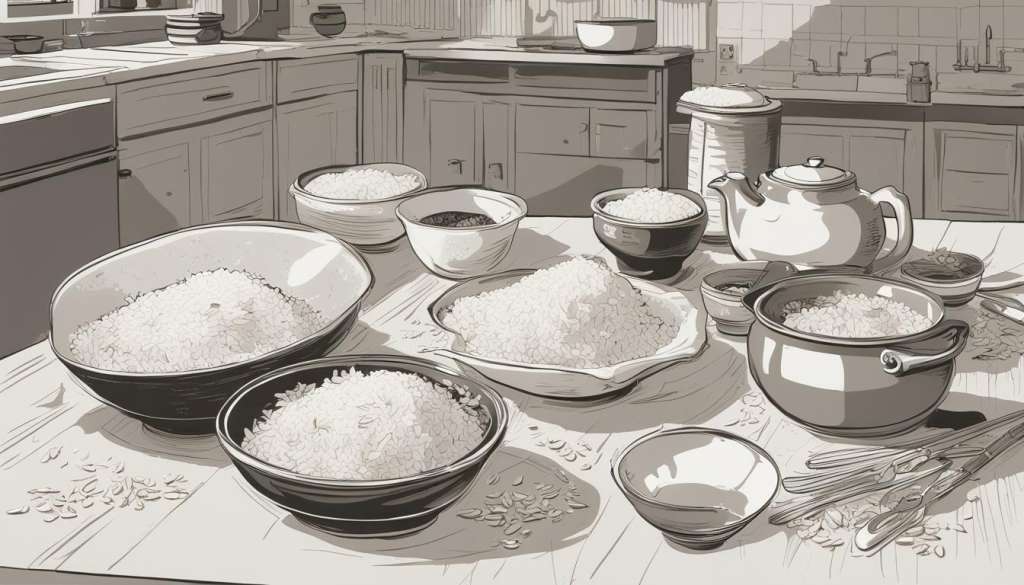
It’s important to regularly check stored rice for signs of spoilage, including off-flavors, unusual odors, and the growth of mold or bacteria. Rice that has gone bad should be discarded immediately.
Optimal Rice Storage Conditions
Proper storage is essential for preserving the quality and safety of unrefrigerated rice. The following tips can help you create the optimal rice storage conditions:
- Keep rice in a cool, dry, and dark place: Store rice away from heat sources, such as stoves or ovens, and avoid areas with high humidity or sunlight, such as near windows or under the sink. Ideal temperatures for storing rice are between 40-70°F.
- Use airtight containers or bags: Hermetically sealed containers or bags can prevent moisture and air from reaching the rice and help reduce the risk of contamination from pests or bacteria. Use food-grade containers with a tight-fitting lid or re-sealable bags designed for food storage.
- Avoid strong odors: Rice can absorb strong odors from other foods or spices, so keep it away from pungent items such as garlic, onions, or coffee.
- Limit temperature fluctuations: Avoid exposing rice to frequent temperature fluctuations, which can cause condensation and promote bacterial growth. Store rice in an area with consistent temperature and humidity levels.
- Store rice in smaller portions: Consider storing rice in smaller quantities to reduce the risk of spoilage. This can also make it easier to rotate your rice stock and use older batches first.
By following these optimal rice storage conditions, you can help prolong the shelf life of your rice and maintain its quality and safety for consumption.
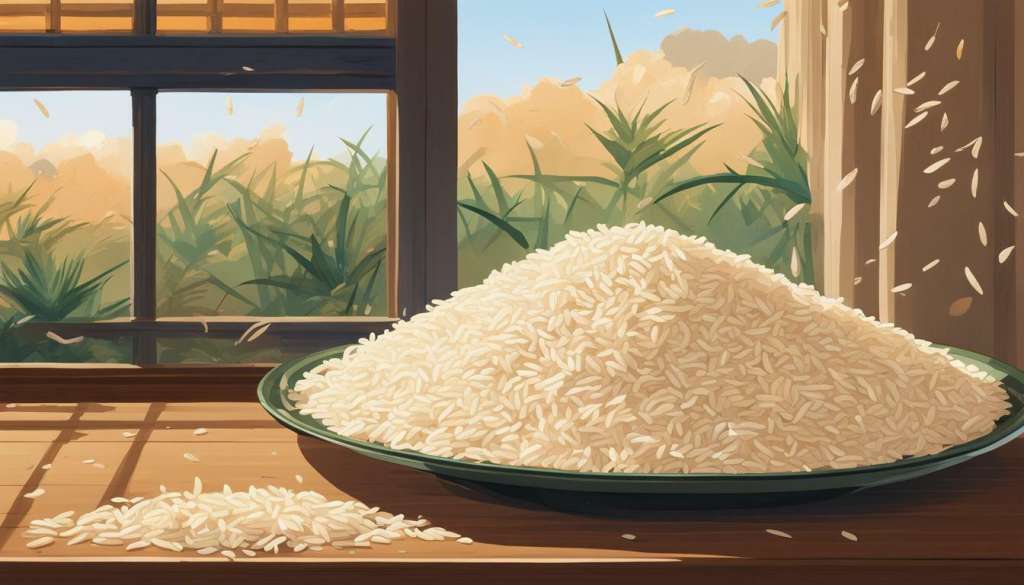
Preserving Rice Freshness
If you want to keep your rice fresh for an extended period, there are several techniques you can use to preserve its quality. Here are some helpful tips for preserving rice freshness:
- Use Oxygen Absorbers: Oxygen absorbers are small packets that can help remove oxygen from storage containers and prevent the growth of bacteria or mold. Place one or two oxygen absorbers in a jar or bag of rice to keep it fresh for longer.
- Add Bay Leaves: When placed in storage containers with rice, bay leaves can help prevent the growth of insects and other pests. The natural oils in bay leaves can also add a subtle flavor to the rice.
- Rotate Rice Stocks: To ensure that your rice stock remains fresh, make sure to rotate it periodically. Use older batches of rice first while keeping newer stock in storage.
By following these tips, you can extend the shelf life of your rice and ensure that it remains fresh and safe for consumption.
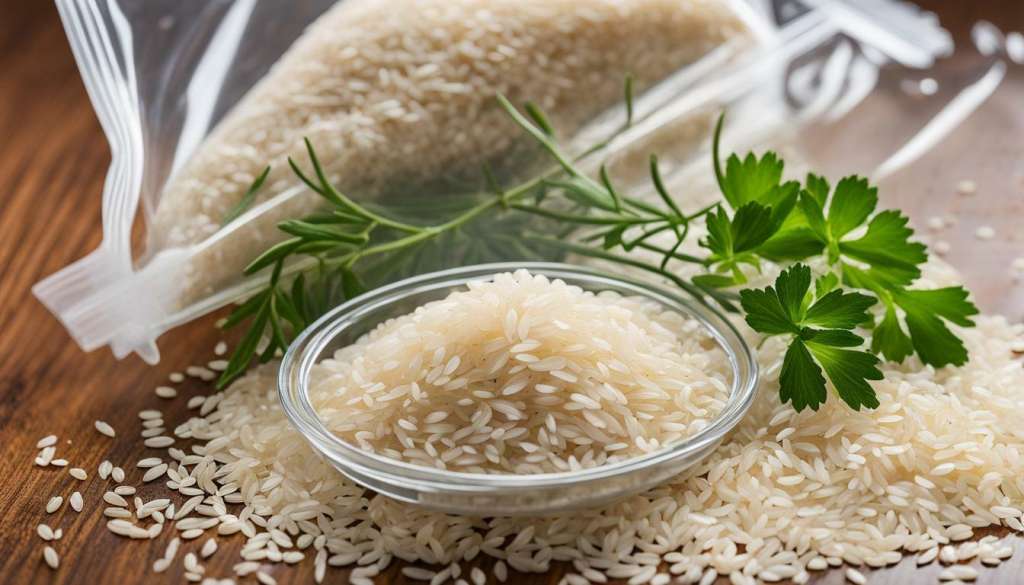
Safe to Eat Unrefrigerated Rice?
Many people wonder if it is safe to eat rice that has been stored unrefrigerated. The answer is that it depends on how well the rice has been stored and whether or not it shows any signs of spoilage.
Rice that is stored in a cool, dry place and protected from moisture, heat, and sunlight can remain safe for consumption for a certain period. However, if the rice has been exposed to any of these factors, it can spoil, resulting in off-flavors, changes in texture, and the growth of bacteria or mold.
It is essential to use your judgment when deciding if it is safe to consume unrefrigerated rice. If the rice has an unusual smell or appearance, it is best to discard it. Additionally, it’s crucial to be careful when handling rice, including washing your hands and utensils to prevent contamination.
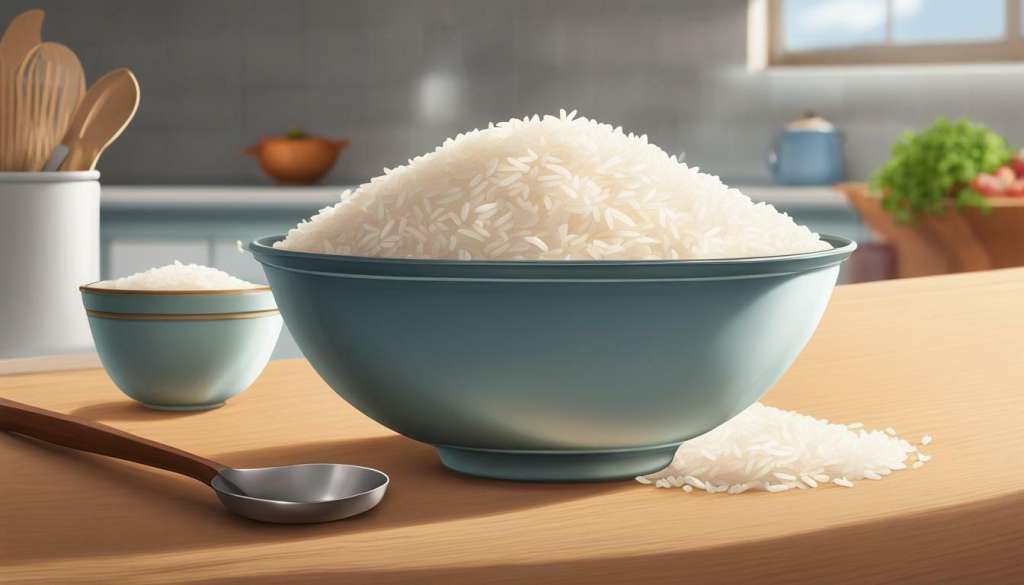
By following proper rice storage guidelines, you can reduce the risk of spoilage and ensure that the rice you consume is safe and delicious. Remember to keep your rice in a cool, dry, and dark place, use airtight containers or bags, and rotate your rice stocks regularly.
Rice Storage Tips
Proper rice storage is essential to maintain its quality and safety. Here are some practical tips for storing rice without refrigeration:
- Store rice in a cool, dry, and dark place. Avoid storing it near sources of heat or moisture, such as the stove or sink.
- Keep rice away from strong odors, such as spices or onions, as it can absorb them.
- Use airtight containers or bags to protect rice from air and pests. This will also prevent moisture and odors from seeping in.
- Limit temperature fluctuations by choosing a stable storage location, such as a pantry or cupboard. Avoid moving rice frequently or exposing it to direct sunlight.
- Store rice in smaller portions to reduce the risk of spoilage. This will also make it easier to use and rotate your stock.
Following these tips will help you extend the shelf life of rice and preserve its freshness. Remember to check for signs of spoilage before consuming stored rice.
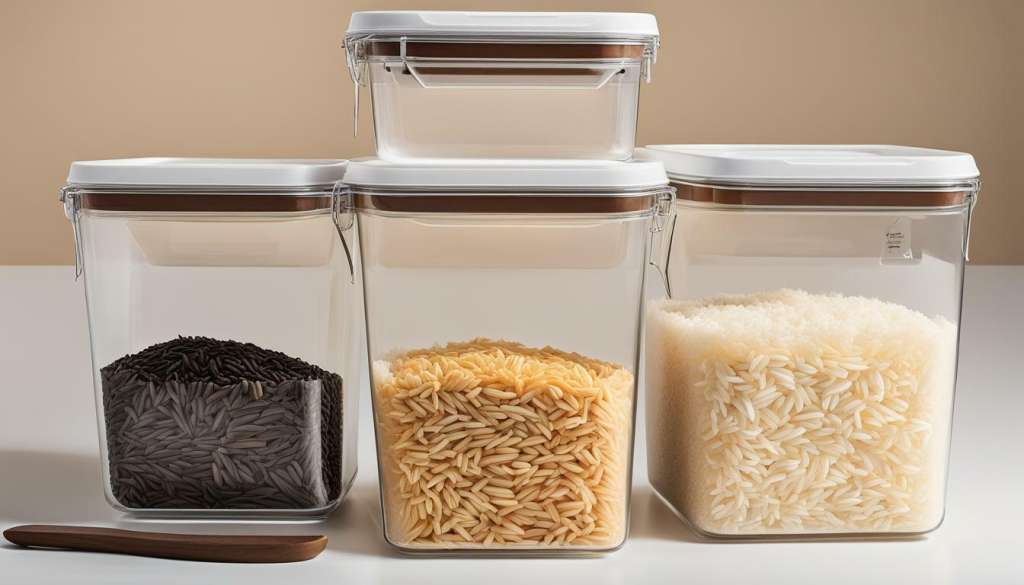
Extending the Shelf Life of Rice
If you want to extend the shelf life of your unrefrigerated rice even further, there are a few additional techniques you can try.
Freezing: One option is to freeze your rice. You can do this by placing it in an airtight container or bag and storing it in the freezer. Frozen rice can last for up to six months, but keep in mind that freezing can affect the texture of the rice. When you’re ready to use it, simply thaw it in the fridge overnight.
| Tip: | Consider freezing rice in smaller portions to make it easier to thaw and use as needed. |
|---|
Vacuum Sealing: Another option is to vacuum seal your rice. This removes air and can help prevent spoilage. You can use a vacuum sealer machine or bags to store your rice. Vacuum-sealed rice can last for up to two years when stored in a cool, dry place.
Specialized Containers: There are also specialized food storage containers designed to keep rice fresh. Look for ones that feature airtight seals and moisture control. These can help prevent moisture, air, and pests from compromising your rice’s quality and shelf life.
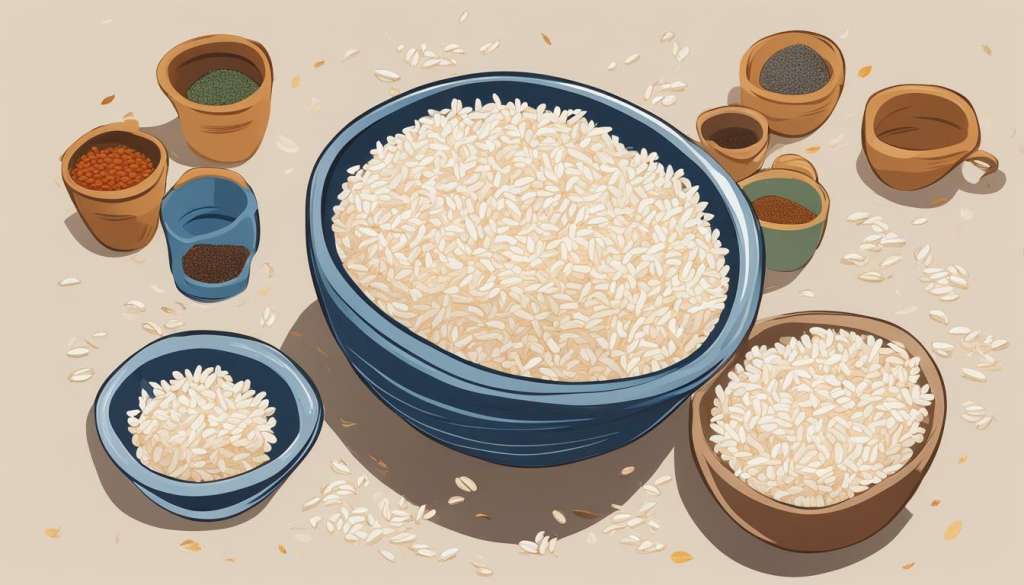
Whatever method you choose to extend the shelf life of your unrefrigerated rice, it’s important to always check for signs of spoilage before consuming it. If you notice any off-flavors, unusual odors, or strange texture changes, it’s best to err on the side of caution and discard the rice. With proper storage and a few extra tricks, you can enjoy your rice for longer and reduce waste.
Conclusion
In conclusion, properly storing unrefrigerated rice is crucial to maintain its quality and safety. Rice quality deterioration can occur due to moisture, heat, and air exposure, leading to spoilage that can result in off-flavors and bacterial or mold growth. Therefore, it is important to follow optimal rice storage conditions such as keeping rice in a cool, dry, and dark place, using airtight containers or bags to prevent air and pest exposure, and rotating rice stocks to use older batches first.
To preserve rice freshness, you can use oxygen absorbers or bay leaves to inhibit bacterial growth and prevent staleness and also store rice in smaller portions to reduce the risk of spoilage. While unrefrigerated rice can be safe to eat if stored correctly, it is essential to handle it with care and avoid consuming rice that shows signs of spoilage or has an unusual odor. By using common sense and judgment, you can ensure your rice stays safe and fresh for an extended period.
Takeaways
- Store unrefrigerated rice in a cool, dry, and dark place.
- Use airtight containers or bags to protect rice from air and pests.
- Rotate rice stocks to ensure that older batches are used first.
- Preserve rice freshness by using oxygen absorbers or bay leaves and storing rice in smaller portions.
- Handle rice with care and avoid consuming rice that shows signs of spoilage or has an unusual odor.
By following these tips, you can prolong the shelf life of your rice and ensure it remains fresh and safe for consumption. Start practicing safe rice storage habits today to protect your well-being!
FAQ
Q: How long does unrefrigerated rice last?
A: The shelf life of unrefrigerated rice can vary depending on factors such as the type of rice, its moisture content, and storage conditions. In general, properly stored rice can last for several months to a few years without refrigeration.
Q: What can cause the deterioration of rice quality?
A: Factors such as moisture, heat, and exposure to air can lead to the deterioration of rice quality. These can result in off-flavors, texture changes, and the growth of bacteria or mold, which can spoil the rice.
Q: What is the typical shelf life of unrefrigerated rice?
A: The typical shelf life of unrefrigerated rice varies based on the type of rice. White rice can last for around 2-5 years, brown rice for 6-12 months, and wild rice for 4-5 years when stored properly.
Q: What are the optimal storage conditions for rice without refrigeration?
A: It is important to store rice in a cool, dry, and dark place to minimize moisture absorption, prevent heat exposure, and avoid sunlight. Using airtight containers or bags can also help protect rice from air and pests.
Q: How can I preserve the freshness of rice?
A: To preserve the freshness of rice, you can use techniques such as using oxygen absorbers or bay leaves to inhibit bacteria growth and prevent staleness. It is also recommended to rotate rice stocks and use older batches first.
Q: Is unrefrigerated rice safe to eat?
A: When stored properly, unrefrigerated rice can be safe to eat. However, it is important to handle rice with care and avoid consuming rice that shows signs of spoilage or has an unusual odor.
Q: What are some tips for storing rice without refrigeration?
A: Some tips for storing rice without refrigeration include avoiding moisture exposure, keeping rice away from strong odors, and limiting temperature fluctuations. Storing rice in smaller portions can also help reduce the risk of spoilage.
Q: How can I extend the shelf life of rice?
A: To extend the shelf life of rice, you can try methods such as freezing rice, vacuum sealing, or using specialized food storage containers. It is also important to check for signs of spoilage before consuming stored rice.


